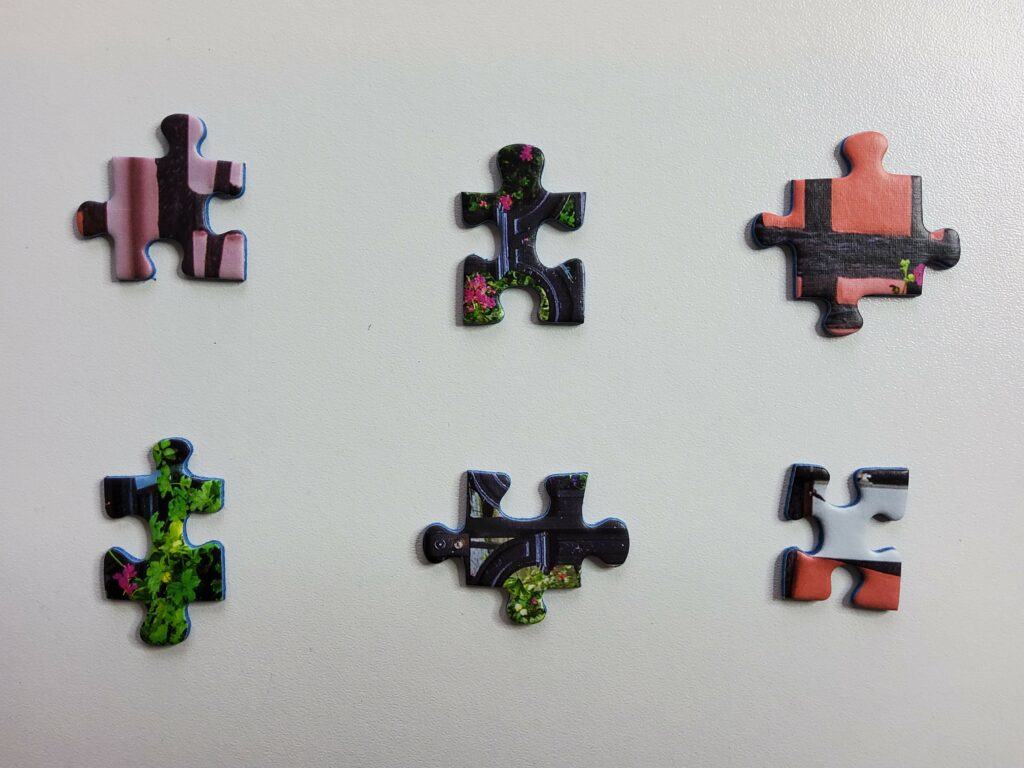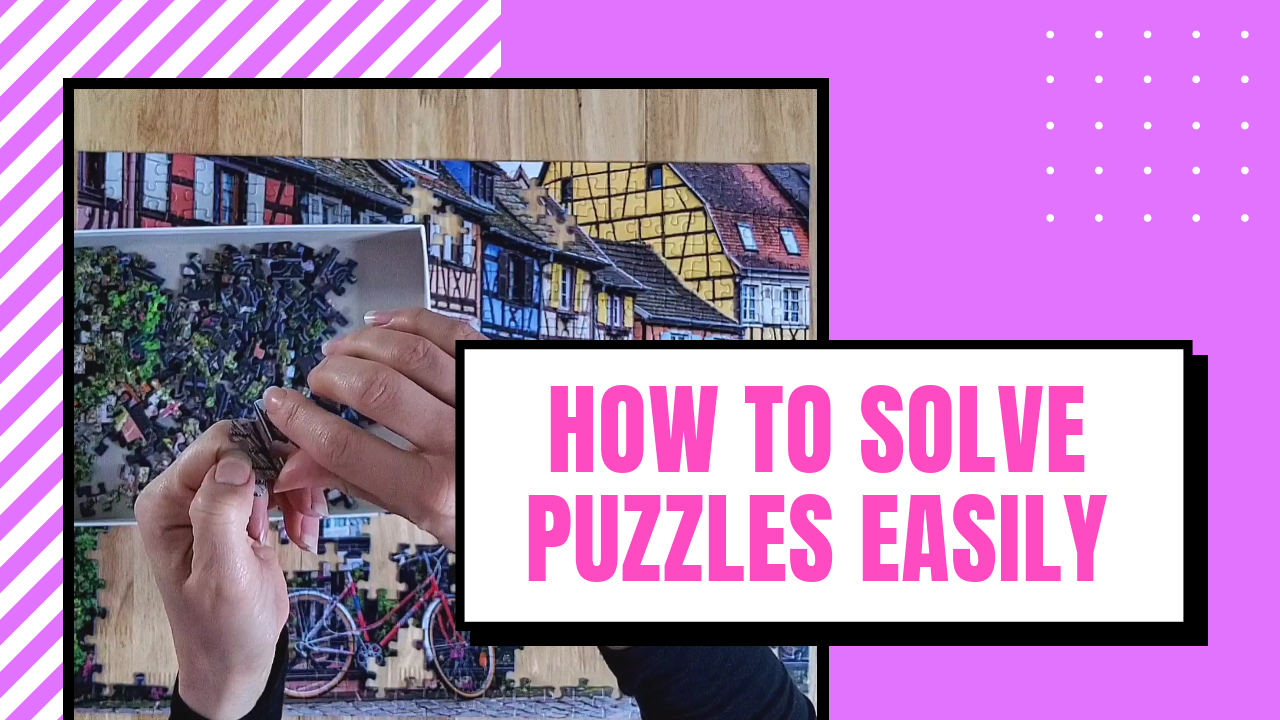In this article I am to look at how to solve a jigsaw puzzle quickly and easily. Completing a jigsaw puzzle is incredibly satisfying and the puzzling experience is so much fun so I am going to share with you the method and tips I find most effective when completing a puzzle.
See our video tutorial for instructions and tips on how to solve a jigsaw puzzle below
1 – Choose your work surface and take a look at the puzzle picture.
Make sure your work space is large enough for your puzzle and you can use it for some time.
It is really tempting to just tear off the wrapping and delve straight in, but stop, take a moment to absorb the picture that you are going to puzzle. This helps you to distinguish the different colors and distinct features in the puzzle before you begin to sort the pieces, which we will talk about next.
2 – Sort the pieces into groups
If you have 1000 pieces to puzzle, it is a massive mix of colors and completely overwhelming, where do you even begin? Begin by sorting the puzzle pieces! Ok, I know this sounds a little boring but trust me it will save so much time in the long run and make the puzzling experience much easier and quicker. If you find this a bit tedious try listening to a podcast or have some tunes on whilst you do it.
Sort the pieces into groups of edge and corner pieces, colours and distinguishing design pieces, for example distinct puzzle pieces include wording or facial features or any particular part of the puzzle that is very distinct. Make sure you turn all your pieces face upwards at this point too.
You will get a real feel for the puzzle whilst you do this and notice features and colors that you probably did not see when looking at the box and see ways you can sort the colors further.
3 – Assemble the border
Now that you have sorted your puzzle it is time to get going! Start by piecing the border and corners together (there are some exceptions where the border is a block color and so on but these are normally harder puzzles that are not ideal if you are just starting out).
If you are missing any border pieces then don’t worry they are going to be hiding somewhere in all your other pieces and will show up later.
By piecing together the borders you have a starting point and the border pieces often lead into other color areas and then you can distinguish and start working on these areas.
4 – Begin assembling the puzzle
Next begin to assemble a particular ‘group’ that you have sorted earlier, either a particular pattern, color or distinct pieces and match the puzzle pieces into place. I would avoid colors that are in multiple places in the jigsaw at the beginning.
Once you have completed a section (or got stuck) move on to another group of pieces that you have sorted. If the last section that you worked on leads into a new section that is an ideal crossover.
5 – Keep going
As you near completion of the puzzle you may find it is becoming more difficult to find the piece you need. Try sorting your puzzle pieces into the different puzzle piece shapes (this is explained in detail in our video tutorial)

If you run out of steam and come to a stand still then take a break, it is amazing how after a time out to relax that the puzzle pieces can just fall into place or try a different perspective and work on your puzzle from another angle.
6 – A few more tips
Pieces with joining colours
Certain color areas can sometimes be defined by a sharp clear line into another area. Finding the pieces that match the color edge can be easy to piece together.
Colour detail
Pieces can have a tiny speck of colour on them to join them to another colour area so watch out for this!
Determining If piece’s match together
Turn your joining pieces over to the light and see if they match smoothly along the edges and if there are any gaps in the joining.
Cover your puzzle when you are not puzzling
Cover your puzzle and put any boxes with pieces safely away when not in use (especially if you have pets or children) Some puzzle boards have a cover that you can put on top of your puzzle.
Have fun
Do not worry about how long it takes you, it’s not a race, the most important thing is to relax and enjoy the puzzle. Happy puzzling.


Hi Maddie, I always used to have issues when doing 1000+ puzzles, I think I never finished it on my own, always needed help. That’s gonna be the way easier with your easy to follow guide.
Once you have a strategy it makes more complex puzzles far easier. I’m very happy to hear that it has helped you!
Hi Maddie, I used to love doing jigsaw puzzles and always found it really satisfying after completing one. Separating colours and is a great tip, as well as covering a jigsaw when you’re not working on it. There are some very complex ones around to challenge enthusiasts. Your post has inspired me to get another jigsaw, and thanks for the handy tips.
Hi Kathy
Thank you I am very happy to hear that my post has helped you. If you are just starting out I would recommend trying a 500 piece puzzle
This is really useful and interesting information about how to solve a jigsaw puzzle quickly. I never thought about placing all of the pieces on a surface and working out. I suppose we just do some of the stuff without thinking. 🙂
Also that starting off with assembling the border first.
You have really helped me out here.
Thanks!
Very happy to hear you found these tips helpful, happy puzzling!
Haha. Great. You have covered the very method that I use to complete my puzzles.
The most important advice is to cover the puzzle, although this does not always prevent it from being ‘dis-assembled.’
My cats love nothing better that to ‘help out’ and cannot resist an open box or lots of loose pieces spread out ready for assembly.
I always move quickly when doing puzzles and view them as a challenge. I really enjoy the process of completing them more than the result of finishing them, so I don’t know why I hurry?
What about you, are you in a rush to finish your puzzles?
Thanks for sharing your tips.